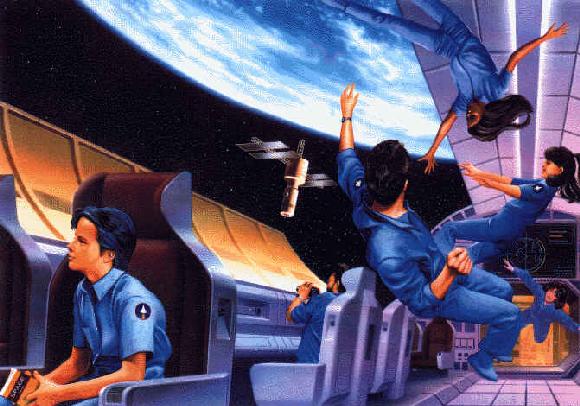Looking out from Earth is also spectacular. According to those who have been to orbit, the stars don't twinkle in space (because there's no atmosphere between you and them) - they're much brighter and "closer", and their colours are clearer. And we mustn't forget that everyone who's been to space so far has been busy, with limited time to spend looking out of the windows. And their windows weren't designed for gazing - yet they still say that the view is amazing.
So imagine a picture window, say, 1 meter across, and you and some friends are lounging in front of it, with drinks in your hands, and just passing the time with this view rolling by in front of you. And you can float round the window in any direction and you can look east, west, north or south and see the stars beyond the Earth's rim... Somewhat better than looking at a picture book.
Evolution in Action
But to get the full flavour of what it will feel like to look down at the Earth from a panoramic window in a hotel lounge - or in a space-suit outside - you have to stand back and look at the present stage of human history in its cosmic background and think of its significance. We humans have evolved on this tiny little planet literally out on the rim of "our" galaxy. It's taken the Earth about 5 billion years, and most of the time this evolution was pretty leisurely. For example, for about a billion years there were just slimy things, and then another billion years or so of fishes, plants and creepy-crawly things. Then once things got moving on the land the dinosaurs were crashing around the place for 150 million years (!) before a huge chunk of rock smashed into the Earth, plunged the place into a freezing night, and wiped them out (scientists are still arguing about the details).
That gave some little tree-living mammals their big chance - and they took it, growing into a whole range of new species, including apes - small, nifty animals which were clever with their hands. Then about 60 million (!) years later a bunch of apes living on the north coast of Africa took to eating shell-fish and swimming a good deal of the time. Like other swamp-living monkeys are doing today, they learned to walk upright. And like a number of other mammals that had taken to the sea before them these monkeys also learned to control their breathing - and then finally to talk.
This mixture was a considerable success! And these walking talking monkeys gradually spread throughout Africa, and then out to Europe and Asia, and then to every possible living place in the entire world - from sweltering jungles to the northern ice-pack, from mountains to marshes, from deserts to the tiniest Pacific islands. Compared to the earlier rate of evolution on Earth, it took them no time at all to discover agriculture and then engineering - enabling them to travel over the seas and through the atmosphere, and to talk and see each other wherever they were.
Call us what you like - the talking animal, the "conscious" animal, the property-owning animal - we're also certainly the animal that spreads out. And now we've reached the next stage, and we're moving on again - just because there's nowhere new left to go on Earth. And this time, the new place we're going to is one zillion times bigger than the whole of the Earth, and we're just on the absolute threshold of literally exploding out through the galaxy...
THAT's what makes looking down at the Earth and out towards space so rivetting. We're looking down on the cradle of this amazing life-form that we are, spinning in the midst of infinite space, and looking out at the galaxy where our descendants are going to spread and have adventures that we can only faintly guess at today. Even for those who don't feel the urge to go on and out themselves, there's a deep fascination in just looking out at it.....
Throughout human history there have been those who've stayed behind, and those who've moved on. And it's "horses for courses" - many, if not most people will stay on the Earth - but some of the human race are going to move on. And you only have to look briefly at human history to see the dynamic economic and cultural effects that discovering new territories also has for the people who stay behind - and who finance the pioneers, among other things! The Roman empire, the British empire, the New World all greatly enriched not only the pioneers, but also the existing economic centers of the day. It's going to be the same again - just as soon as some big business can get started in space to pay back the investment. And that day is surprisingly close now.
Zero Gravity
said. "Earth is the planet of sea and clouds"
Akiyama
said. And the view at any time certainly depends on the local weather below you, but it's continually changing as you go right round the Earth every 90 minutes or so. And provided you're in a high inclination orbit (that is one which is at a large angle to the equator, and so goes over places at high latitudes) then you get to see most of the Earth as it rotates below you.




